Key takeaways
- A well-configured tripod setup enhances stability and control, allowing for sharper images and creative photography.
- Different tripod types, like compact travel tripods and monopods, offer unique advantages for specific shooting environments.
- Key features to focus on include stability, tripod head type, height, and portability to suit your shooting needs.
- Careful setup and attention to small adjustments, such as leg angles and locking mechanisms, are essential for achieving the best shots.
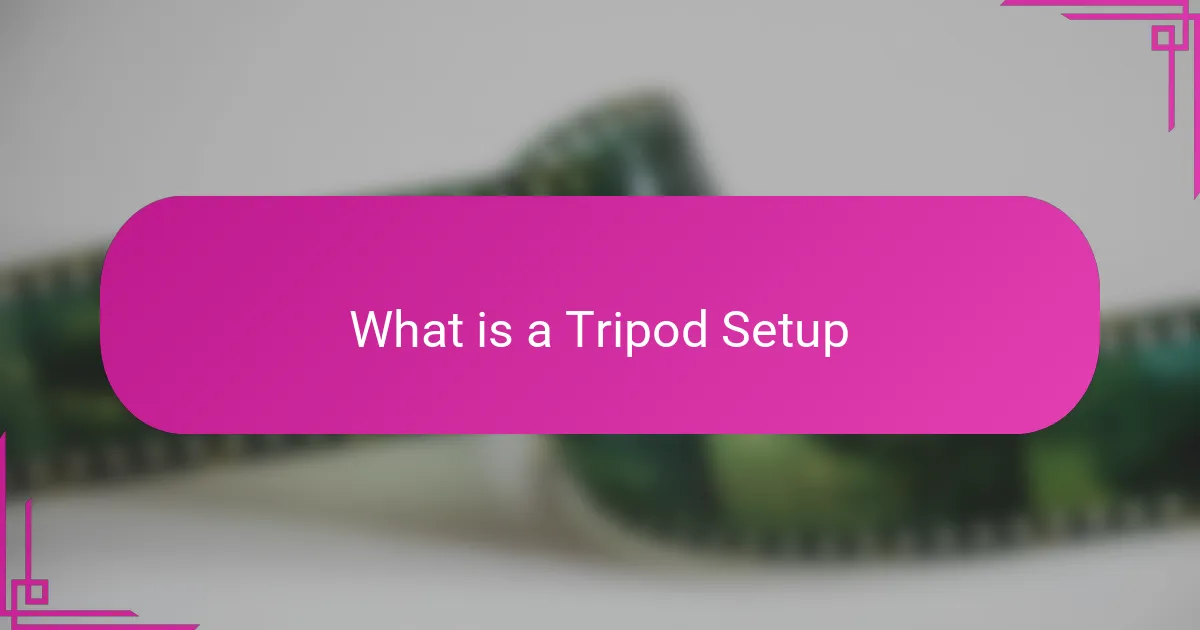
What is a Tripod Setup
A tripod setup, in my experience, is more than just a camera mounted on three legs. It’s the precise arrangement of the tripod itself, the head, and any accessories that stabilize your camera and help you frame the perfect shot. Have you ever felt the difference between a wobbly, rushed photo and one that’s steady and sharp? That’s the power of a well-configured tripod setup.
For me, setting up a tripod involves considering factors like leg extension, the angle of the legs, and how tightly the head locks in place. It’s a bit like preparing a stage where my camera performs best. This careful balance ensures I can capture those fleeting moments without worrying about blur or instability.
What I find most rewarding about a tripod setup is the control it gives me. When I configure it just right, I feel confident to experiment with long exposures or tricky compositions, knowing my equipment will hold steady. It’s that feeling of readiness and precision that makes all the difference in my photography.
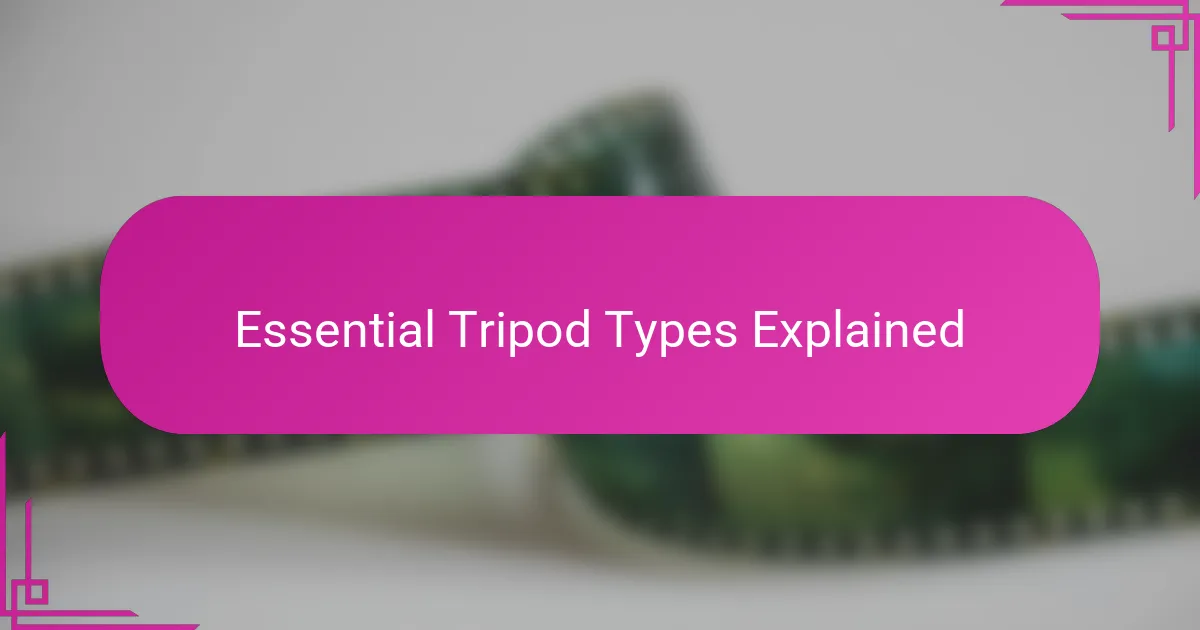
Essential Tripod Types Explained
When I first started using tripods, I was surprised by how many types there are—each with its own personality and purpose. The classic tripod with adjustable legs is my go-to; it offers stability and height, perfect for landscapes or studio shoots. But have you ever struggled with bulky gear on a hike? That’s when I turn to compact travel tripods, which are lighter and easier to carry without sacrificing too much steadiness.
Then there’s the monopod, which I didn’t appreciate at first. It’s just one leg, so it doesn’t provide full stability, but I realized it’s incredibly handy for fast-moving environments like sports or wildlife photography. It’s almost like having a stabilizing arm rather than a full stand, giving me freedom to move quickly while still reducing camera shake.
I also learned to love the flexible tripods with bendable legs. They let me wrap around tree branches or uneven surfaces—something rigid tripods simply can’t do. Have you ever tried balancing a tripod on a rock or railing? Those flexible models have saved me more times than I can count, turning tricky spots into creative opportunities.
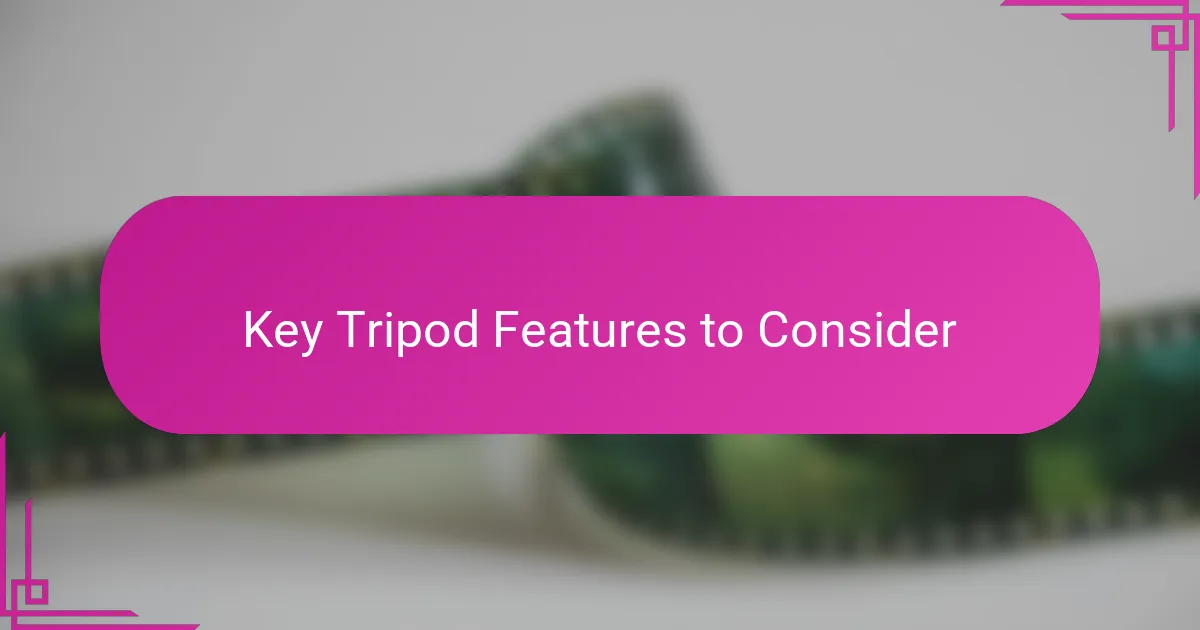
Key Tripod Features to Consider
For me, the first feature I always check is the tripod’s stability. Does it feel solid when I spread the legs? I remember once shooting a sunrise and realizing my tripod’s flimsy locks caused a slight shake, blurring the entire sequence. Having strong leg locks and a sturdy build means fewer worries about accidental shifts during those critical moments.
Another key aspect I never overlook is the tripod head. Ball heads give me quick adjustments, while geared heads offer precision. Depending on the shoot, I choose what feels right. Have you ever tried framing a shot where every millimeter counts? That’s where a smooth, reliable head can make or break your composition.
Height and portability also play big roles in how I configure my setup. When hiking, a lightweight tripod that extends tall enough for eye-level shots is a lifesaver. Carrying cumbersome gear drains my energy, so finding that balance keeps me focused on photography, not on aching shoulders. What’s your priority—steady support or easy transport? For me, it’s about syncing both seamlessly.
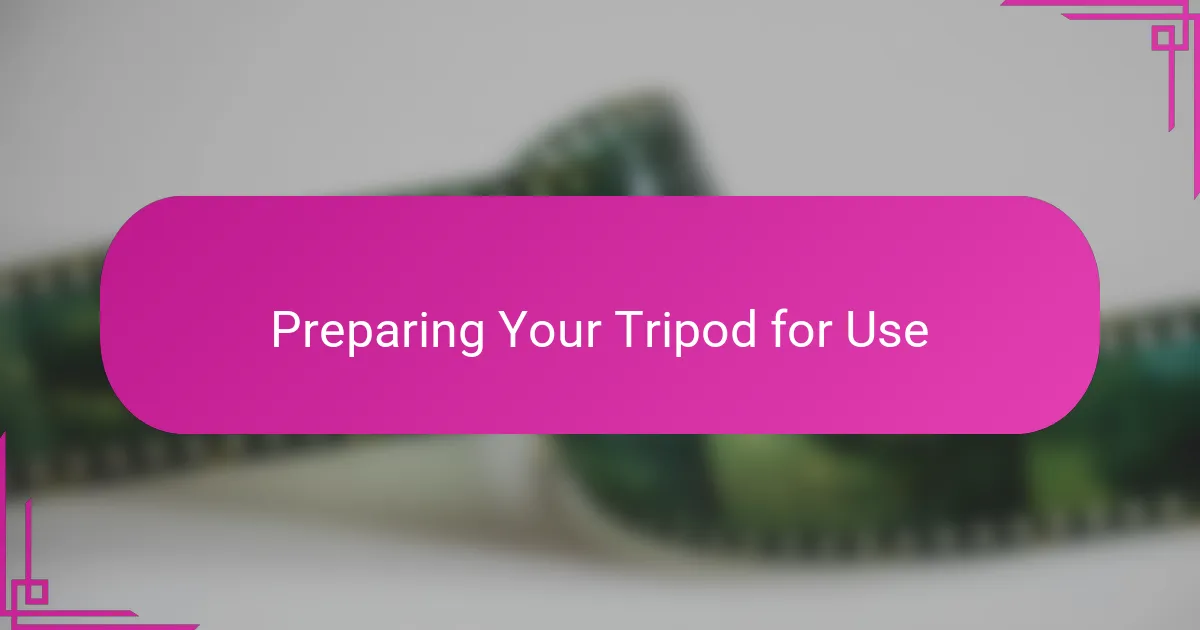
Preparing Your Tripod for Use
Before I even extend the tripod legs, I like to check that all the locks and joints are clean and functioning smoothly. Nothing’s worse than getting to a remote spot only to struggle with a stuck leg or a wobbly head. Have you ever had a moment where your tripod just wouldn’t cooperate? That frustration sticks with me, so I always do a quick once-over to avoid it.
Next, I spread the legs wide to establish a solid base—sometimes angling them differently depending on the terrain. On uneven ground, I’ve learned to adjust each leg length individually, which feels like tuning an instrument before the performance. It makes all the difference between a shaky frame and rock-solid steadiness.
Lastly, I attach my camera and tighten every lock with deliberate care, almost like I’m preparing for a delicate operation. I’ve found that this mindful approach not only secures the gear but also calms my mindset before shooting. Isn’t it amazing how a simple ritual like this sets the tone for the entire session?
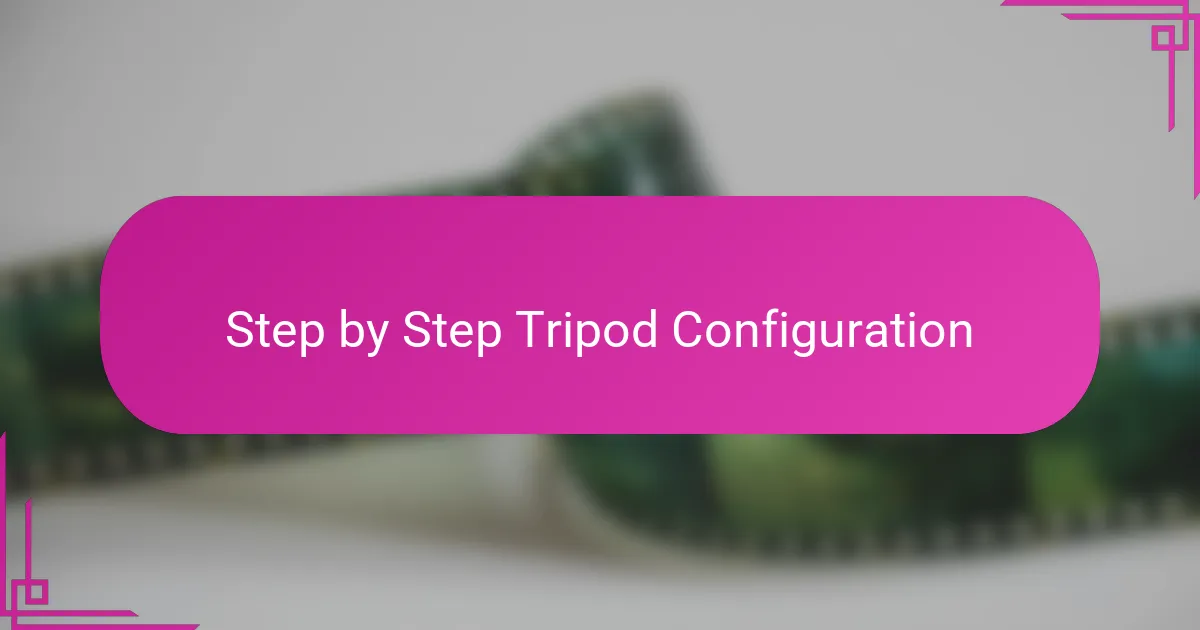
Step by Step Tripod Configuration
Starting with the tripod legs, I always extend them step by step, making sure each section locks firmly before moving to the next. Have you noticed how rushing this part can make your whole setup unstable? Taking my time here feels like laying the foundation for a strong, reliable support system.
Next, adjusting the leg angles is crucial—sometimes wider for more stability or narrower if I need to fit into tight spaces. I remember one shoot on rocky terrain where tweaking the angles saved me from a shaky disaster. It’s these little adjustments that really build confidence in the steadiness of the shot.
Finally, I focus on the tripod head, securing it tightly and aligning it perfectly with my intended composition. I often pause here, feeling that moment of calm before the click. Don’t underestimate this step—it’s where precision meets patience, and where your image truly comes to life.
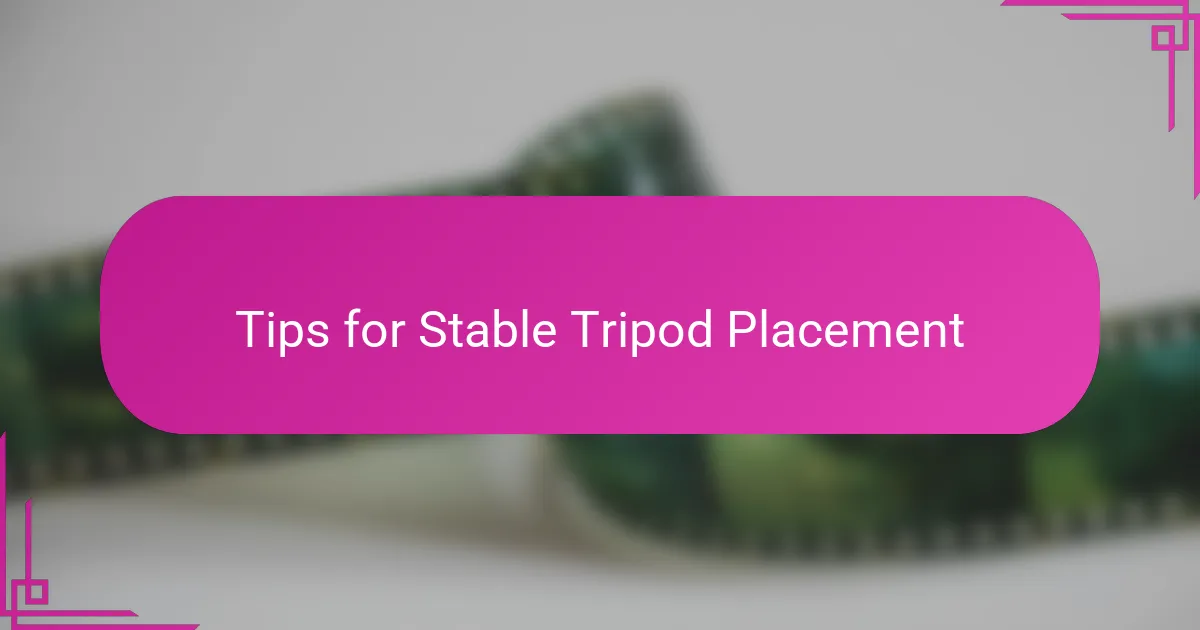
Tips for Stable Tripod Placement
One thing I always keep in mind is placing my tripod on a firm, level surface. Have you ever set up on soft ground only to watch your camera tilt unexpectedly? That sinking feeling of instability can ruin an otherwise perfect shot, so I make sure to test the ground first and adjust my tripod feet accordingly.
I also tend to spread the legs wider for added stability, especially in windy conditions. It’s a small adjustment that makes a big difference. I remember a beach shoot where strong gusts threatened to topple my setup, but widening the stance kept everything rock solid—it’s like giving your tripod a more confident footing.
Sometimes, uneven terrain can be tricky, but I’ve found that individually adjusting leg lengths is a game-changer. Why struggle with a crooked horizon when a bit of leg tweaking can level your camera perfectly? That little extra effort means sharper shots and less frustration, and honestly, I feel more in control every time.
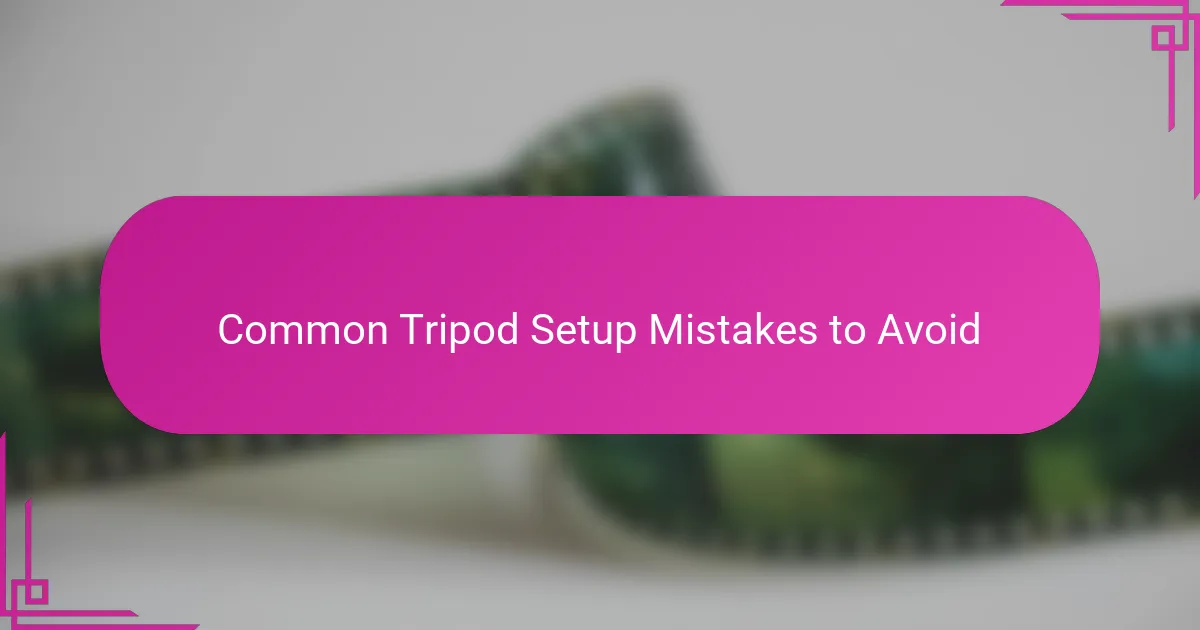
Common Tripod Setup Mistakes to Avoid
One mistake I see way too often is not fully securing the leg locks. I once hurriedly set up on a trail and didn’t double-check the clamps; halfway through the shoot, a slight wind caused the legs to collapse a bit. It’s amazing how a simple oversight like that can turn a promising shot into a blur—have you ever had the heart sink when your camera wobbles unexpectedly?
Another trap is ignoring the angle of the legs. I used to keep them too narrow to save space, but that made the tripod prone to tipping, especially on uneven ground. Widening the stance might feel awkward at first, but it’s a small adjustment that pays off with rock-solid stability, especially when I’m battling windy conditions or rough terrain.
Finally, I’ve learned never to rush the head adjustment. I recall a frustrating session where I didn’t tighten the ball head enough, and my composition slowly drifted out of frame. That moment taught me that patience and care in locking everything down aren’t just about gear—they’re about respect for the craft and the moment you’re freezing in time. Have you noticed how a little extra care at this stage changes everything?